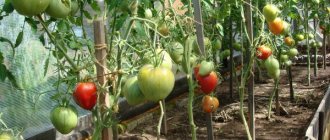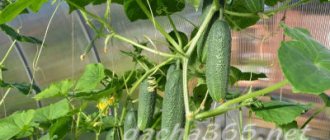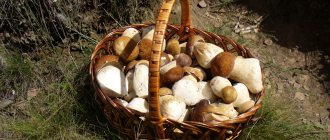Growing tomatoes is a troublesome business. Despite the apparent simplicity of cultivation, this crop requires both special conditions and certain care. For example, how you tie tomatoes directly affects their yield and presentation. Despite the fact that in our climate, garter is almost always required - tomato fruits do not tolerate contact with the ground, no matter whether it ripens in the garden or in the greenhouse.
Brief overview of the article
- Why is tomato garter required?
- How to properly tie tomatoes?
- Equipment and materials
- Tomato garter: when should you start?
- How to tie tomatoes in open ground?
- How to properly tie tomatoes in a greenhouse
- Low-growing varieties: garter tomato in open ground
- Garter tomato of medium-sized varieties
- How to tie up tall varieties of tomatoes?
- Garter tomato: common mistakes
- Photo of tomato
Why is tomato garter required?
Depending on the species, plants cannot always quickly adapt to existing climatic conditions, which requires the introduction of special growing techniques. Gartering is one of the ways to preserve the harvest.
Moreover, tall varieties are, in principle, difficult to grow without external support, which must be taken into account before tying up tomatoes in open ground or in a greenhouse.
In general, “helping” tomato bushes always makes sense, as it allows:
- Simplify plant care.
- Organize uniform lighting and ventilation.
- Reduce the spread of fungal infections.
- Prevent stem damage.
Watering tomatoes
When watering tomatoes, it is necessary to direct the stream to the middle of the row. Soil erosion and exposure of roots are not allowed, water should not get on fruits and leaves. Watering is done in the first half of the day. The water temperature should be below 20-25 C in warm weather, and heated to 25-30 C in cold weather. With good soil moisture, tomatoes can survive temperatures of 32-35 C.
When further growing seedlings, regular watering is necessary. To do this, you need settled water at room temperature. You also need to loosen the soil and add fresh mixture. Due to the fact that seedlings are drawn to the light, they must be periodically turned 180 degrees.
When there are 10-12 days left before planting seedlings, it is necessary to limit watering and accustom the plant to direct rays. If weather conditions permit, you can place the seedlings in a greenhouse overnight and take them outside during the day.
Tomatoes need weeding, staking, fertilizing and watering, as well as the destruction of pests and diseases.
How to properly tie tomatoes?
The rules for strengthening bushes can vary significantly, depending on the availability of available material, the method of fixation, and the variety of tomatoes. In general, gardeners recommend adhering to the stages of fastening: first, the central stems are grabbed, and then, as the fruits ripen, the side branches.
Also, different varieties require different approaches. For example, for tall bushes, tomato gartering in open ground is carried out a week after planting.
The stem must be fastened sequentially, from bottom to top, as it grows. Weak-growing varieties are fixed in the middle part of the bush. In this case, the bandage should not be tight, otherwise over time it will push through the plant.
Methods
The simplest known method is to tie it to a wooden or metal peg driven into the ground. Each bush has its own peg driven nearby, and a variety of materials are used as garter material - nylon stockings, cord from household appliances, ribbons and straps. The bush is tied near the crown of the stem.
The advantage of this method is that garter materials can be used every year. The downside, as already mentioned, is the possible infection of plants with diseases remaining on the garter materials from last year. But there is a way out here too - disinfection of all materials before new use.
An important point is not to tighten the stem with garter materials, so as not to damage it and expose the plant to death. As the bush continues to grow, it is necessary to equip it with new garters or raise the old one as it grows.
Let's complicate the garter a little by using trellises. We place them at some distance from each other and stretch a wire horizontally between them. Between the rows of wire we make a distance of 45cm. Actually, rows of bushes will be tied to these wires.
A metal mesh can serve as a good guide for tomato bushes, but its cells must be large
The third method is called linear. A wire is pulled in the middle between the stakes, then a rope is stretched to it above each tomato, one of its ends is attached to the stem of the bush.
The fourth method is to make each bush its own cage. The cage is made of wire or metal. We bend the circles that will be connected by rods. We plant a tomato bush, dig the cage to a depth of 15 cm and tie it with a rope.
The next method is to use pyramidal caps made of four rods each. Each cap holds four bushes and when planting a plant, it is dug down to 25 cm, and the tops of the rods are connected with wire.
The sixth method involves the use of hooks and wire. On both sides of the tomato row, stakes are dug in, between which a cable is stretched. After 30 cm from it, a fishing line or twine is stretched, to which rings and hooks are attached. The hooks will catch the stems of the tomato bushes.
Video: review of tomato garter techniques
Equipment and materials
The production of fixing devices depends on how and what varieties of tomatoes are planned to be strengthened. In general, the products used should not be rough, have sharp edges or thorns.
On the other hand, thin wire and fishing line are also not suitable, as they can injure the stem. Usually, understanding how to properly tie tomatoes determines both the material and the necessary preparations.
Most often, the following are used to maintain stems and bushes:
- Metal or wooden stakes.
- Hooks.
- Grids and frames.
- Twine, twine or cord.
- Fabric strips.
You should use last year's wrappings with caution, as pathogenic bacteria and fungi may remain on them.
What materials are used for tying tomatoes?
To tie the stems, you should not use materials that are too thin, such as fishing line, wire, or thin rope. They can easily cause damage to the stem by cutting into soft tissue or disrupt the supply of nutrients. Experienced summer residents recommend using for these purposes:
- thick twine;
- fabric strips 2-3 cm wide;
- old elastic stockings or tights;
- purchased clip fastenings;
- specially designed garters (work on the principle of a stapler).
Low-hanging massive brushes can be supported with homemade slingshots made from cut branches.
On a note! If you decide to use last year’s material, it must be disinfected (boiled or kept in a “Whiteness” solution).
All unusual ways of gartering tomatoes involve using original supports and garter material. You don't have to buy everything you need at a hardware store. Some people make a trellis from an old television antenna.
Branches left over from pruning fruit trees, willow twigs and hazel, blackberry stems and cut grapevines or other vines are used. You can build a support from hoops of different diameters, which are attached to three pegs. The smallest hoops should be at the bottom, and the hoops with the maximum diameter should be at the top. As the bush develops, the shoots are fixed to the hoops with plastic clips.
You can make V-shaped inverted trellises with their bases embedded in the ground. The bush will be located under them; in this case, no garter is required; the shoots are simply passed through the grate. The bush will independently hold the structure in place.
Tomato garter: when should you start?
When a plant grows so much that it is not able to maintain a vertical position on its own, then it is time to “help” it. Usually by that time the stem has already reached a thickness of 1 centimeter and throws out up to 10 leaves.
Basically, tying is carried out based on the ripening period:
- Early: you need to start a month after planting.
- Average: after 1.5 months or on the 60th day.
- Late: no earlier than 3.5 months after planting.
Deadlines
As soon as 8 to 10 leaves appear and the stem reaches a thickness of a centimeter, you can begin gartering. Focus on fruit ripening based on the variety. This directly leads to the periods of the procedure.
Carry out the following garters by assessing the size of the bush and the nature of its growth. For a low-growing, miniature plant, one is enough. Some species won't need it.
How to tie tomatoes in open ground?
This growing method is chosen for unpretentious or super-determinate varieties that require minimal outside support. As a rule, with such a garter, either a frame or trellises are installed. Less often - individual stakes.
In this case, it is necessary to take into account adverse weather factors, such as heavy rain or wind, which may affect the integrity of structures. Moreover, with an increase in planting area, making trellises may turn out to be too expensive.
How to properly tie tomatoes in a greenhouse
Most often, greenhouses are used for breeding tall varieties of tomatoes that require special support, which is difficult to provide in large areas in the field.
In modern hydroponic technologies, the following support options are distinguished:
- On a trellis (horizontally or vertically).
- Using wire frames.
- Panel.
- Rope, fastened to a ceiling beam.
- Using a mesh (nylon).
- On stairs or gratings.
Features of gartering medium and tall tomatoes
Medium-sized (determinant) tomatoes can be tied once. This is usually done at the fruiting stage, when the clusters may break off under the weight of the fruit. You need to tie up the central stem without touching the side shoots.
For such tomatoes, a linear tying method is used, when wire or thin twine is pulled between two supports located at different ends of the greenhouse. It is not recommended to use a linear garter for powerful indeterminate bushes due to the increased load. You can use individual supports in the form of stakes or a wire frame with which the bush is wrapped around the perimeter, constructing something like a wide pipe.
Tall bushes are often fixed vertically, although a horizontal trellis in the form of rows of wire stretched between two metal posts can also be used. The use of vertical trellises involves attachment to a strong rope fixed under the roof.
Plastic or metal nets are very convenient to use, onto which you can tie both the main stem and fruiting branches with massive tassels. As the bush grows, the old fastening is removed and the plant is tied in another, more convenient place.
Low-growing varieties: garter tomato in open ground
When growing such tomatoes, it is extremely important to exclude possible contact of the fruit with the soil. To do this, the stem and, if necessary, branches are tied to a pre-installed support.
The procedure should be repeated as the bush grows. Typically, for low-growing varieties, the time for tying occurs after the first ovary appears.
The stem needs to be fixed in the middle. The limiter is a wooden peg, a metal or plastic rod, or a rope stretched along the bed.
Benefits of a garter
A garter is needed for the following reasons:
- Without it, there is a high chance that the plant stem will break, especially after the appearance of juicy fruits.
- Tethered tomatoes are much easier to spray and process in other ways: weed the soil around them, hill up or mulch.
- Tethered plants receive much more sunlight and are better ventilated. This increases fertility and promotes development.
- Positioning high above the soil helps protect leaves and fruits from mice, slugs and other pests.
- Watering tied plants is easier because you can avoid unwanted large amounts of moisture getting onto the foliage.
- The likelihood that precipitation will harm your crop is minimized.
You may not need to tie up only low-growing varieties of tomatoes, but often this will not be superfluous for them either. Well, if we are talking about those varieties that can reach two meters or more, it is absolutely impossible to do without this procedure.
Garter tomato of medium-sized varieties
These plants only have to be strengthened once. Typically, determinate varieties (medium-sized bushes) are recommended to be tied during the period of fruit formation, which reduces the breaking off of lateral branches and brushes. As a rule, it is enough to fix only the middle of the stem.
Support is provided using a simple single-level trellis, with a rope stretched between the supports, or by installing pegs. A rope loop or tape can be used as a binding.
After sowing
After sowing, for germination, the trays are covered with plastic film or glass and placed in a warm place. When shoots appear, it is necessary to move them to the brightest place, and also remove the film or glass. For the first 5 - 6 days, it is necessary to reduce the temperature to 10-12 C, and at night to 8-10 C. After which the seedlings should be grown at a daytime temperature of 17-19 C, and in sunny weather a temperature of 25 C is acceptable. During this period, moderate watering is needed and loosening the soil, as well as additional lighting. The duration of daylight should be 14 hours, the maximum is 18.
After 15-25 days, 2-3 true leaves appear. Timely harvesting into separate pots with a diameter of 8-10 cm is necessary.
How to tie up tall varieties of tomatoes?
Cultivation of hanging or climbing varieties of tomatoes involves the organization of ascending attachment of stems. In most cases, they are grown in greenhouses, since it is easier and cheaper to organize support there.
In principle, tall tomatoes can be planted directly in the ground, but in this case you will have to switch to the trellis or trellis method, which significantly increases costs. Sometimes plastic mesh stretched between supports or rows of rope are used as a cheap alternative.
Harvesting tomatoes
When the fruits are fully ripe (the shine appears along the way), they can be harvested. If this needs to be done earlier, then you can collect the browned fruits, and then place them in boxes, and after a certain time, they will ripen themselves (they will acquire the color we need). These tomatoes can ripen in one day or a week, so you should check them daily.
Tomatoes must be stored on the stem side at room temperature, in a place protected from direct sunlight.
svoyadacha.net
Garter tomato: common mistakes
Beginning gardeners are often faced with poor harvests, constant breaking of stems and massive spoilage (rotting) of fruits due to incorrect or untimely gartering. To avoid such cases, you should follow simple rules:
Do not use hard material for strapping. Scotch tape or thin wire cannot be used!
Do not reuse used fasteners. This is especially true for loops made of natural fabrics.
Comply with the requirements for the varieties grown. Ignorance of how to properly tie tomatoes leads to the fact that many bushes are tied below the required level or without additional strengthening. In addition, it is not uncommon to install incorrect supports, for example, trellises for medium-growing varieties or short stakes for climbing varieties.
Do not ignore the climatic conditions and natural features of a particular region. If there is often strong gusty wind where tomatoes are grown, you need to take care of the strength of the fastenings and supports.
Despite the prevailing opinion that gartering a tomato is a troublesome task and in most cases not at all necessary, you need to clearly understand when and what you can do your own way.
It should be remembered that only following the care recommendations and understanding the peculiarities of growing crops will ensure the required quality of ripe tomatoes and high yields in general.
Why is the tying procedure necessary?
Despite the fact that the plant stems may be strong, experienced gardeners still recommend tying up the bushes. As a rule, many varieties of tomatoes require this procedure. An important point is tying up tall plants, which can reach a height of up to 2 m.
If we are talking about low-growing varieties of tomatoes, then they do not need tying. However, such varieties are less often used by summer residents, since every gardener tries to rationally use the territory of the plot. And tall crops allow you to save space, as they take up less space.
Tying tomatoes is an important agricultural technology procedure. Performs the following functions:
- During the period of fruit growth, the stems are not damaged under the weight of ripe tomatoes. Culture does not expend energy on survival, but directs it to ensure high productivity;
- Since the bush grows vertically, the plants' access to light and fresh air increases. Shrubs begin to grow and develop better;
- Precipitation in the form of rain is not dangerous for tomatoes. If the plant grows vertically, then the stems, shoots and fruits will not rot;
- A tied bush simplifies the spraying procedure;
- In addition, it simplifies other maintenance procedures, such as mulching, hilling, weeding;
- When watering tomatoes, avoid getting water on the foliage of the plant. The tying process makes it easier to fulfill this condition;
- Since during the tying process the fruits are located high above the ground, this allows them to be protected from damage by mice and slugs.
Based on the above arguments, we can conclude that tying up bushes is a necessary and useful procedure. You need to start the process of tying up plants 15-20 days after the seedlings are planted in their permanent place of growth. Read about how to tie tomatoes in a greenhouse in another article.











